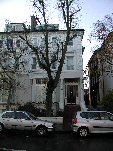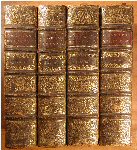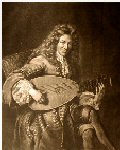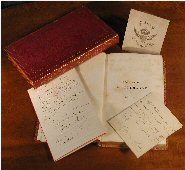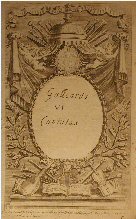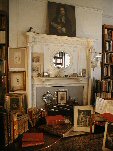Associate: Dr. Ulrich Drüner
Update January 2009:
|
ARNOLD, Samuel (1740-1802). Huit Sonates, Pour le Clavecin ou le Forte-Piano, Dédieés The Miss Hornby’s, Composées Par Samuel Arnold, Œuvre X., Gravées par Mdame. Olivier. A Not in BUC. RISM A 2463 (4 copies, all in
Order no. 0901 L001 £320
|
|
BACH, Carl Philipp Emanuel (1714-1788). Six Fugues pour le Piano Forte Composées par C. Ph. E. Bach. RISM B 106. Wotquenne 119. These six works were written mainly for Marpurg’s collections (Fu- Order no. 0901 L002 £175 |
||||||||||||||||||||||||||||||||||||
|
BARBANDT, Charles (1716- after 1775). Four favourite Italian Songs, Accompany’d with Violins, German Flute and Hautboy, To which are added Two Sonatas for the Harpsicord, Compos’d by Charles Barbandt, Opera terza. RISM B 859 (2 copies). BUC p. 83 (1 copy). A member of the Hanoverian court orchestra Barbandt (“junior”) left and settled in Order no. 0901 L003 £375 |
||||||||||||||||||||||||||||||||||||
|
BEALE, William George Frederic (fl. 1846-1857). Spectre Avenger. Libretto by Lawford Burne, Music by W.G.F. Beale. [ Unknown stage work by little known composer, completely unpublished in any part or form, set to a libretto by an unkown author. CPM lists some slight piano pieces and songs by this composer and a collection of psalmody arranged by him for the Portman Chapel (near Order no. 0901 L004 £1500 |
||||||||||||||||||||||||||||||||||||
|
BEETHOVEN, Ludwig van (1770-1827). Grande Sonate pour le Pianoforte, composée par Louis van Beethoven. Oeuv. 7. Leipzig: au Bureau de Musique de C.F. Peters, [1814?]. Score, 19pp., en- Kinsky-Halm p. 17. From the plates of the second published edition, first issued in 1805 by Hoffmeister & Kühnel. Beethoven’s Op. 7 is one of his longest piano sonatas (substantially more so than the Appas- Order no. 0901 L005 £175 |
||||||||||||||||||||||||||||||||||||
|
BEETHOVEN, Ludwig van (1770-1827). Tre Sonate Per il Clavicembalo o Forte-Piano con un Violino, Composte, e Dedicate al Sigr. Antonio Salieri primo Maestro di Capella dell Corte Im- Unrecorded variant of the first edition. Kinsky-Halm p. 28. BUC p. 95. The sonatas were first advertised in the Wiener Zeitung of 12th January 1799; it is usually thought that one of them was played in a benefit concert in March 1798 for the singer Josefa Duschek when Beethoven and Schuppanzigh played. Order no. 0901 L006 £1800 |
||||||||||||||||||||||||||||||||||||
|
BEETHOVEN, Ludwig van (1770-1827). Les Adieux, l’Absence et le Retour. Sonate Pour le Pianoforte composée et dédiée à Son Altesse Impériale L’Archiduc Rodolphe d’Autriche par L. v. Beethoven, Oeuv. 81. à Leipsic: Chez Breitkopf & Härtel, [1821]. Score, 17pp., lithographed, oblong 4to, plate number 3686. Sewn, with marbled paper backstrip, a little light foxing. Third edition. Kinsky-Halm p. 217. The French title to this sonata (originally ‘Das Lebewohl, Abwesenheit und Wiedersehn’) originated in the separate German and French editions of 1810 by Breitkopf & Härtel. It is one of Beethoven’s most popular sonatas with its atmospheric writing and programmatic nature. Order no. 0901 L007 £275 |
||||||||||||||||||||||||||||||||||||
|
BEETHOVEN, Ludwig van (1770-1827). Six Thémes Variés bien faciles à executer pour le Piano-Forte seul avec accompagnement d’une Flûte ou d’un Violon (ad libitum) par Louis van Beet- First edition. Kinsky-Halm p. 290. During the commissioning of these works George Thomson wrote to Beethoven “It would be quite desirable if you wrote the variations in a style that is familiar and easy and a bit brilliant, so that the majority of our ladies may play them and relish them”. Of the twelve sets commissioned nine were published, six as Op. 105 and three further as Op. 107, the latter published by Simrock. Order no. 0901 L008 £900 |
||||||||||||||||||||||||||||||||||||
|
BEETHOVEN, Ludwig van (1770-1827). Quatuor pour deux Violons, Alto et Violoncelle, compose et dédié à Son Altesse Monseigneur le Prince Nicolas de Galitzin, Lieutenant Colonel de la Garde de Sa Majesté Impériale de toutes les Russies, par Louis v. Beethoven, Oeuvre 127. Mayence: chez les fils de B. Schott, [1826?]. Set of parts: 1 f. (title), 13, 12, 11, 11pp., engraved, folio, plate number 2351. Sewn in plain green wrappers. First edition, second issue with the Prince Nicholas Galitzin, the dedicatee and an amateur cellist, asked Beethoven in November 1822 for one-three string quartets; he had made quartet and quintet transcriptions of Beethoven’s piano sonatas. It was not until 1825 that the three quartets (Opp. 127, 130 and 132) eventually appeared, this Op. 127 in February was premièred by the Schuppanzigh Quartet on 6th March. “For Beethoven, E-flat major is often a key of grand rhetoric and emphatic gestures, and the majestic declamation of the first measures of Op. 127 is one of his typical E-flat openings in the tradition of the Eroica … and the ‘Emperor’ Concerto” (The Beethoven Quartet Companion, edited by Winter and Martin, p. 218). Order no. 0901 L009 £950 |
||||||||||||||||||||||||||||||||||||
|
BERG, George (ca. 1730s-1775). Twelve Sonatinas, or Easy Lessons for the Harpsichord Chiefly intended for the Improvement of Young Practitioners. Composed in various Styles, by George Berg, Op.[V]I. RISM B 2014 (only two copies). Not in BUC. Quite an extensive composer, with concerti grossi, songs, voluntaries and sonatas to his name, little is known of Berg. He was probably very involved with the music at the pleasure gardens called Ranelagh (six sets of songs sung at Ranelagh are men- Order no. 0901 L010 £250 |
||||||||||||||||||||||||||||||||||||
|
BERTOJA, Valentino (fl. late eighteenth century). Sonata Terza Per il Violoncello col Basso, Del Sigr. D. Valentino Bertoja in Napoli. [S.l.: ca. 1900]. Score: 6 ff., oblong folio, manuscript in ink, on 12-stave paper. Folded. This composer is not listed in the usual reference works although Antolini refers to him as “a musi- The copyist of this manuscript has noted “from the library of …” and cryptically left it blank; he also copies out a label from inside the original manuscript which gives information on the copyist and publisher Luigi Marescalchi, here, helpfully copied in full. Order no. 0901 L011 £80 |
||||||||||||||||||||||||||||||||||||
|
BLANC, Monsieur [BLANCK, Nicholaus]. Six Duets, For German Flutes, Composed by Monsr. Blanc. BUC, p. 111. RISM B 2837 I, 1 (only two copies, GB (British Library) and US (Newberry Library)). This composer is not cited in the usual reference works nor Vester’s Flute Music of the 18th Century. Order no. 0901 L012 £220 |
||||||||||||||||||||||||||||||||||||
|
BOYCE, William (1711-1779). Ten Voluntaries for the Organ or Harpsichord, Composed by the late Dr William Boyce. BUC p. 131 (3 copies). RISM B 4176 (8 copies). William Boyce became a composer to the Chapel Royal in 1736, a position for which he also had to play the organ; on the death of one of his teachers, Maurice Greene, he became master of the King’s Musick in 1755 although he was not officially an organist to the Chapel Royal until the death of John Travers in 1758. Boyce’s extensive music library was auctioned soon after his death by Christie & Ansell. Order no. 0901 L013 £250 |
||||||||||||||||||||||||||||||||||||
|
BRANDI, Gaetano (fl. 1773-1802). Solo For a German Flute, And Basso Obligato Composed & Dedicated to Samuel Phelps Esqr. By Gaetano Brandi. Not in BUC or RISM. A little known single edition comprising a work which is not one of the sona- Order no. 0901 L014 £120 |
||||||||||||||||||||||||||||||||||||
|
BRITTEN, Benjamin (1913-1976). On this First edition. Banks et al, p. 39. Dedicated to Christopher Isherwood. Although issued as “Volume I” and despite other settings of Auden’s work a second volume did not appear during the com- Order no. 0901 L015 £75 |
||||||||||||||||||||||||||||||||||||
|
BROGIALD, Tito. Gran Duo Concertante per Due Violini con accompagnamento di Orchestra di Tito Brogiald. Omaggio al Nobil Uomo Sir. Barone Franco Mistrali, Insegne Letterato ed egregio Dilettante di Musica. [
This composer is not cited in the usual reference works. Order no. 0901 L016 £450 |
||||||||||||||||||||||||||||||||||||
|
[CASTRO, Antonio de]. Duetti galanti e facili. No. XXIV da Cantarsi al Cembalo; s’aggiungono no. VI Canoni a tre voci, Gli uni, e gli altri composti da vari celebri Autori viventi. Dedicati a sua eccellenza Andrea Giulio Corner, Patrizio Veneto. In Venezia: presso Antonio de Castro, MDCCLXVI [1766]. Score: 2 ff. (title, dedication), 44 pp., typeset, oblong folio. Plain textured wrappers, dust marked. Internally excellent. RISM B/II p. 161 (2 copies only). Sartori, Dizionario degli Editori Musicali Italiani, pp. 56-57. The authors in this collection are anonymous. Order no. 0901 L017 £340 |
 |
|||||||||||||||||||||||||||||||||||
|
CECERE, Carlo (1706-1761). Twenty Four Duets for two German Flutes or Violins, Compos’d by Sigr. Carlo Cecere of BUC p. 175 and RISM C 1679 (the same 2 copies). Smith & Humphries no. 347. Only one other published work (a flute concerto) is known by this composer although part of his infamy rests on the music he wrote for a satiric comic opera by P. Trinchera, La tavernola abentorosa, for which the king ordered both the poet and his publisher to be arrested. Cecere took sanctuary but was soon incar- Order no. 0901 L018 £280 |
||||||||||||||||||||||||||||||||||||
|
CERVETTO, James (1748-1837). Twelve Divertiments In an Easy Stile For Two Violoncell’s. Most Humbly Inscrib’d To John Smith Eqsr., By his most Gratefull And Obedient Humble Servant James Cervetto Junr., Opera 2da. RISM C 1733 (7 copies, 2, at least, of which are in parts unlike this copy in score). BUC p. 176. From the collection of Alfred Moffat with his notes to front end-papers. Cervetto, a child prodigy, first appeared in concert at the age of 12; he was taught cello by his father Giacobbe Cervetto who was also a cellist and composer. He later taught another great cellist, Robert Lindley, who dominated the scene in the nineteenth-century. This Op.2 set are very much duos with both players being of equal dexterity. Order no. 0901 L019 £300 Another copy, disbound. [2 copies] Order no 0901 L019a £250 |
||||||||||||||||||||||||||||||||||||
|
CERVETTO, James (1748-1837). Three Duetts for Two Violoncellos or a Violin and Violoncello, Composed & Humbly Dedicated to The Earl of Aylesford, by James Cervetto, Op. 6. Book I [and II]. RISM C 1741 (6 copies, 3 of which in the British Library). Not in BUC. The lower part with contem- “Cervetto's op.3 solos are different from those of op.1, their melodic lines being more direct and the rhythms more four-square. They include much rapid passagework and are more demanding for the player than the op.4 sonatinas, which were obviously intended for amateur use” (New Grove). Order no. 0901 L020 £275 |
||||||||||||||||||||||||||||||||||||
|
CLARKE, WHITFELD, John (1770-1836). Twelve Glees, In which are Included the Two Favorite Airs, Of Sally in our Alley, and, Savourna delight. Harmonized for Four Voices, With an Accom- First edition. With the composer’s signature. The piano advertisement includes four illustrations. Order no. 0901 L021 £150 |
||||||||||||||||||||||||||||||||||||
|
CLEMENTI, Muzio (1752-1832). Six Progressive Sonatinas for the Piano Forte, Composed and Fingered by Muzio Clementi, Op. 36.
BUC p. 199 (2 copies). RISM C 3026 (3 copies of which 1 incomplete). “Clementi was in great de- Order no. 0901 L022 £175 |
||||||||||||||||||||||||||||||||||||
|
DALE, Joseph (1750-1821). Six Sonatinas for the Piano Forte or Harpsichord, with an Accom- BUC, p. 249. RISM D 748 (9 copies). A later printing of the 1783 edition with the publisher’s address visibly altered to the later period. Joseph Dale was very active as a music publisher and seller from 1783 in addition to his lesser known activities as a composer and organist; he produced the first editions of several operas by Stephen Storace. [Wm 1800 / Betw 1800-02] Order no. 0901 L023 £120 |
||||||||||||||||||||||||||||||||||||
|
FESTING, Michael Christian (d. 1752). Six Solo’s for a Violin and Thorough-Bass, Dedicated to William Morgan of Tredegar Esqr. compos’d by Michael Christian Festing, Opera Settima. First edition. RISM F 679. BUC p. 333. Privilege, dated 1744, printed on verso of title-page, dedica- Order no. 0901 L024 £150 |
||||||||||||||||||||||||||||||||||||
|
FLORIO, Charles Haiman (1768?-1819). The Egyptian Festival, A Favorite Opera, as now Per- Sole edition. RISM FF 1192 I, 1 (2 copies). BUC p. 341. Set to a libretto by Andrew Franklin (d. 1845). “In the summer of 1794 Elisabeth Mara caused a scandal by leaving her husband and running off to Bath with young Florio. He accompanied her to Order no. 0901 L025 £200 |
||||||||||||||||||||||||||||||||||||
|
FODOR, Josephus Andreas (1751-1828). Six Duo a deux Violons, Dedie a MonsieurPolock le fils, par Monsieur Fodor l’ainé, VII oeuvre. [S.l.: ca. 1800]. Parts: 20, 19 ff., French manuscript in ink, on 14-stave paper, folio. Original English contemporary quarter leather and marbled boards. The duos appear to be a manuscript copy of those published in 1790 by Imbault as Op. 7 [RISM F 1310, also published as Op. 11 by Hummel in Order no. 0901 L026 £220 |
||||||||||||||||||||||||||||||||||||
|
GIORDANI, Tommaso (ca. 1730-1806). Six Grand Lessons for the Harpsichord or Piano Forte, With an Accompanyment for a Violin, Composed by Sigr. Giordani, Op: 32. BUC p. 381 (2 copies). RISM G 2305 (4 copies). Giordani was very involved in the theatre music world firstly in Order no. 0901 L027 £320 |
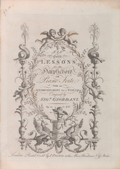 |
|||||||||||||||||||||||||||||||||||
|
GIORDANI, Tommaso (ca. 1730-1806). Three Favorite Sonatas for the Harpsichord, or Piano Forte with an Accompanyment for the Violin, Composed by Sigr. Giordani, Op: 32. BUC p. 381 and RISM G 2306 (1 copy only). These sonatas were first published as “Trois Sonates … par Mr. Schobert … Oeuvre XX”. “Giordani's gifts as a prolific and versatile composer were suffi- Order no. 0901 L028 £220 |
||||||||||||||||||||||||||||||||||||
|
GLUCK, Christoph Willibald (1714-1787). Gavotte von C.W. Gluck, für das Pianoforte gesetzt und Frau Clara Schumann zugeeignet von Johannes Brahms. First edition, second issue. McCorkle p. 621. First published in late 1871 or early 1872 the theme is based on the gavotte from Gluck’s Iphigénie en Aulide. The work commences with Gluck’s charm- Order no. 0901 L029 £120 |
||||||||||||||||||||||||||||||||||||
| to the top | ||||||||||||||||||||||||||||||||||||
|
GUGLIELMI, Pietro Alessandro (1728-1804). Six Divertiments [sic] for the Harpsichord, and Violin, Composed by Pietro Guglielmi, and Dedicated to the Honble. Albinia Hobart [Op. 2]. BUC, p. 409. RISM G 4985. Gugliemli was a highly important Neapolitan opera composer. He lived in Order no. 0901 L030 £320 |
  |
|||||||||||||||||||||||||||||||||||
|
HAYDN, Joseph (1732-1809). The Eighty Third and last Quartett, For two Violins, Tenor, & Bass, Composed & Dedicated to Monsieur Le Compte Maurice de Fries by Joseph Haydn. [Op. 103, Hob. III/83]. First English edition. RISM H 3597 (1 copy only, incomplete). Hirsch III.301. “The unfinished quartet, Op. 103, is indeed a strange and in some ways a prophetic work … The treatment is rather like that of Mozart in his most serious mood: there is life here, not perhaps so much grace and charm, but an abundance of determination; hardly like the work of an aged man” (Barrett-Ayres, Joseph Haydn and the String Quartet, p. 352). Order no. 0901 L031 £400 |
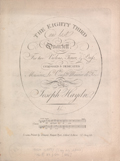 |
|||||||||||||||||||||||||||||||||||
|
HAYDN, Joseph (1732-1809). Trois Sonates pour le Clavecin ou Forte Piano, Composés par J: Haydn, Oeuvre 41 [i.e. 23, Hob. XVI/40-42]. a RISM H 3920 (5 copies). Order no. 0901 L032 £200 |
||||||||||||||||||||||||||||||||||||
|
HAYDN, Joseph (1732-1809). Die Schöpfung, Ein Oratorium In Musik gesetzt von Hrn Jos: Haydn, Doctor der Tonkunst &c. Auf Quartetten, für zwei Violinen, Viola, und Violoncello über- RISM H 4165 (5 copies, 1 of which incomplete). Haydn’s Creation was hugely successful at the outset, especially in Order no. 0901 L033 £350 |
||||||||||||||||||||||||||||||||||||
|
HOFFMEISTER, Franz Anton (1754-1812). Trois Duos pour Deux Violons, Composés par F.A. Hoffmeister, Oeuvre XVII. à RISM H 6084 (3 copies of which one incomplete, none in GB). Not in BUC. Hoffmeister was another composer who first started out to practice law; he wrote numerous works and is well known for the publishing house he set up in Order no. 0901 L034 £220 |
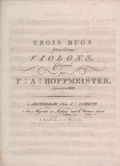 |
|||||||||||||||||||||||||||||||||||
|
HONEGGER, Arthur (1892-1955). Quatuor pour deux Violons, Alto et Violoncelle. Paris: Les Éditions de la Sirène, 1921. Score, 48pp., small 8vo. Printed wrappers with cloth tape reinforcement around backstrip, some red ink markings.
First edition. Inscribed and signed in ink by the composer on the verso of the front wrapper “au “Flonzaley Quartett” avec toute mon admiration, A. Honegger”. The “Flonzaley” string quartet was started by the banker Edward J. De Coppet in 1902 for private performances at his residence. Named after his summer residence near Lake Geneva Coppet’s stipulation was that the members rehearsed and played only with each other. After a successful European tour they were established as one of the most important quartets in the Order no. 0901 L035 £220 |
||||||||||||||||||||||||||||||||||||
|
HUMMEL, Johann Nepomuk (1778-1837). XIII Variazioni, con aggiunta di Coda in fine, Com-
Second edition. Zimmerschied p. 27. Constapel p. 145. Ownership signature of Miss Cornewall. These variations were composed in 1801, this second edition shortly following the first; at this period Hummel taught a great deal and composed late into the night. Order no. 0901 L036 £125 |
||||||||||||||||||||||||||||||||||||
|
ISAAC, Elias (1747-1793). The Black-Birds. A Cantata Set to Music by MR. Isaac, Organist at BUC p. 548. RISM I 86 (5 copies). Isaac is thought to have been a pupil of Maurice Greene. He was a lay clerk at Order no. 0901 L037 £120 |
||||||||||||||||||||||||||||||||||||
|
JUST, Johann August (ca. 1750-1791). Six Divertissements Pour Clavecin Ou forte Piano Avec Accompagnement De Violon, Composés par J.A. Just, Maitre de Musique de S.A.R. Madame La Princesses d’Oranges & Nassau &, Oeuvre VI. A Sole edition. RISM J 765 (2 copies or which 1 incomplete). Not in BUC. With publisher’s catalogue on p. 1 of the keyboard part: Johannson no. 110. Ownership signature dated 1780. “German keyboard player, composer and violinist. According to early chroniclers, he studied with Kirnberger in Order no. 0901 L038 £320 |
||||||||||||||||||||||||||||||||||||
|
KIRKMAN, Jacob (1710-1792). Six Sonatas for the Harpsichord or Piano Forte, Dedicated with Respect To Mr Keeble, Composed by Jacob Kirkman. [Op. 1]. This imprint not in BUC or RISM. The publisher’s plate number would appear to be from the Blundell edition (RISM K 631). Jacob Kirkman was described by Fanny Burney as “the first harpsichord maker of the times”. Along with the other harpsichord builders in Order no. 0901 L039 £275 |
||||||||||||||||||||||||||||||||||||
|
KOZELUCH, Leopold (1747-1818). Duo [a 4 mains] Pour Le Clavecin ou Pianoforte, Composed by L. Kozeluch, Ouvre [sic] 19. BUC p. 577 (2 copies). RISM K 1678 (8 copies). Poštolka XI/3, p. 249. Kozeluch abandoned his studies to be a lawyer in favour of a life in music after initial successes with ballet; in Order no. 0901 L040 £95 |
||||||||||||||||||||||||||||||||||||
|
LOLLI, Luigi Bichi. Trois Sonatas, Violoncello Obligato e Piano Forte, Sigr. B. Lolli. [S.l.: ca. 1811]. Parts: 23, 13 ff., manuscript in ink, on 10-stave paper. Sewn. Three sonatas numbered “4” in G (larghetto, minuet and trio, rondo), “5” in D (cantabile, allegro vi- Order no. 0901 L041 £260 |
||||||||||||||||||||||||||||||||||||
|
MABELLINI, Teodulo (1817-1897). Messa Concertata, per mezzo soprano, Tenore, Baritono e Basso, Con Cori, e Accompagnement d’Organo, Violoncelli, e Contrabassi. Compsta dal Maestro Commre. Tedulo Mabellini. [Italy: ca. 1850]. Score: [ca. 340 pp.], copyist’s manuscript in ink, on 10-stave paper. Half cloth with marbled boards, front cover detached and backstrip broken at front hinge. Mabellini was an Italian composer of many operas and some church music who finished his studies with Mercadante with the help of a scholarship from the Grand Duke Leopold II; he was also a con- Order no. 0901 L042 £400 |
||||||||||||||||||||||||||||||||||||
|
MAZZINGHI, Joseph (1765-1844). Twelve Lessons for the Piano Forte, Composed By J. Mazzinghi, Op. 53.
RISM MM 1647a (1 copy only). Not in the British Library. Mazzinghi, a pupil of J.C. Bach and of Sacchini, spent almost the whole of his life in Order no. 0901 L043 £150 |
||||||||||||||||||||||||||||||||||||
|
MORINI, Alessandro. Harmonies, La Priére de l’exile. Romanza per Violino Coll’accompagna- With a dedication opposite the title of the piano part: “Ferdinando Morini, Offre in Segno d’Amicizia e Stima All’ Egregio Maestro Sigr. Professore Alamanno Biagi, un Ricordo del Sul Figlio Alessan- Order no. 0901 L044 £175 |
||||||||||||||||||||||||||||||||||||
| to the top | ||||||||||||||||||||||||||||||||||||
|
MOZART, Wolfgang Amadeus (1756-1791). Fuga o sia Quartetto, per 2 Violini, Viola, é Violon- RISM M 5552. Köchel6 p. 618. BUC p. 709. The fugue is an arrangement of the two-piano fugue KV 426 of 1783. Order no. 0901 L045 £230 |
||||||||||||||||||||||||||||||||||||
|
MOZART, Wolfgang Amadeus (1756-1791). Variations pour le Forte-Piano, composes par W.A. Mozart. No. 7. [KV 455]. à Leipsic: au Bureau de Musique de C.F. Peters, [ca. 1815]. Score: 11pp., engraved, oblong folio, plate number 231. Folded as issued, outer fold worn, generally foxed, two small brown marks to title-page. RISM M 7058. Köchel6 p. 456. Variations on “Unser dummer Pöbel meint” from Gluck’s La Recontre imprévue. This is a re-issue by Peters from the Bureau de Musique plates of their 1803 edition. Tchaikovsky later orchestrated these in his Mozartiana Op. 61 as a tribute to Mozart. Order no. 0901 L046 £75 |
||||||||||||||||||||||||||||||||||||
|
MOZART, Wolfgang Amadeus (1756-1791). Mozart’s Selection of piano-Forte Music. Consisting of Single Sonatas, Duets, Trios, Quartetts, Airs with Variations &c., with and without Accompani- RISM MM 7483s and t (two parts from this series otherwise not listed by RISM). Not in the British Library which holds four other numbers from the series. Order no. 0901 L047 £185 |
||||||||||||||||||||||||||||||||||||
|
MOZART, Wolfgang Amadeus (1756-1791). Musikalischer Spass für zwei Violinen, Bratsche, zwei Hörner und Bass, geschrieben in Wien den 14ten Juny 1787 von W.A. Mozart, 93tes Werk. Neue Auflage [KV 522]. Offenbach a/M: bei Johann André, [ca. 1860]. Set of parts: 7, 5, 5, 4, 2, 2pp., engraved, folio. Folded as issued, cloth tape along outer fold of first primo part. Charming title vignette of musicians performing this work. Order no. 0901 L048 £180 |
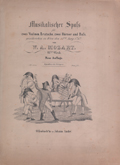 |
|||||||||||||||||||||||||||||||||||
|
MOZART, Wolfgang Amadeus (1756-1791). Dom Juan. Opera de W.A. Mozart, arrangée en Quatuors à Deux Violons, Alto & Violoncelle. Livre I. [only. KV 527]. à RISM M 4631. Hirsch IV.136. Order no. 0901 L049 £250 |
||||||||||||||||||||||||||||||||||||
|
MOZART, Wolfgang Amadeus (1756-1791). A Complete Collection of Mozart and Beethoven’s Symphonies, In Score, Most Respectfully Dedicated, by Permission, to H.R.H. The Prince of Wales. No.1 [i.e. 13]. [KV 543]. Not in RISM. Second issue of Cimador’s first edition of the full score. Order no. 0901 L050 £280 |
||||||||||||||||||||||||||||||||||||
|
MOZART, Wolfgang Amadeus (1756-1791). Trois Quatuors Pour Deux Violons, Alto & Violon- RISM M 6177. Köchel6 p. 650 etc.. BUC p. 709. Hirsch IV.156. An early edition of the “Prussian” quartets, written in 1789 and 1790 and being his last string quartets, notable for the fine engraved portrait of Mozart on the title of the primo part; the other three parts are a London reprint of the Amsterdam edition. Order no. 0901 L051 £230 |
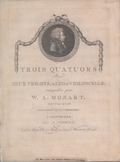 |
|||||||||||||||||||||||||||||||||||
|
MOZART, Wolfgang Amadeus (1756-1791). Die Zauberflöte. Grand Opera ridotta in Duetti Per Due Violini overo Due Flauti, del Sigr. W.A. Mozart [KV 620]. [ Probable transcription of the Artaria publication of 1792 (RISM M 5002). Order no. 0901 L052 £180 |
||||||||||||||||||||||||||||||||||||
|
MOZART, Wolfgang Amadeus (1756-1791). La Clemenza di Tito. Grand Opera ridotta in Quar- RISM M 5194 (no copies in GB). Not in BUC. Order no. 0901 L053 £325 |
||||||||||||||||||||||||||||||||||||
|
[MOZART]: Volume of libretti; the five English publications with parallel translation in prose and all items with cast-list. Small 8vo, modern half calf with original marbled boards, through pagination in neat contemporary manuscript. Armorial bookplate of William Erle. 1. Il Don Giovanni; dramma, in due atti. Don Juan; a grand opera, in two acts, represented for the first time in London, at the King’s Theatre, in the Haymarket. The music entirely by Mozart. 2. Il Flauto magico; o i Misteri d’Iside. The Magic Flute; or, the Mysteries of 3. Le Nozze di Figaro; or, the Wedding of Figaro: an heroi-comic opera, in Two Acts, as repre- 4. Il Barbiere di Siviglia, a Comic Opera, In Two Acts; as performed at the King’s Theatre, in the Haymarket. The music by Sig. G. Rossini. 5. Il Matrimonio Segreto; or, the Secret Marriage: a comic opera, in Two Acts: as represented at the King’s Theatre, in the Haymarket. The music by Cimarosa. 6. Le Café des Variétés, Prologue en Vaudevilles, par Mm. Eugène Scribe, et H. Dupin, A l’occa- Order no. 0901 L054 £350 |
||||||||||||||||||||||||||||||||||||
|
[OPERA]. Volume of nine opera arias in full score from the Order no. 0901 L055 £475 Comprising:
|
||||||||||||||||||||||||||||||||||||
|
PLEYEL, Ignaz (1757-1831). Sei Duetti Per due Violini del Signor Ignazio Pleyel, Opera 19. [ RISM P 4050 (1 copy only (Milan Conservatorio)). Not in BUC. “On 15 November 1785 he [Marescalchi] obtained an exclusive royal licence for the printing of music in Naples, and, in partnership with his brother Francesco, he began to publish there in 1786 … he opened his own shop, where he sold music and instruments as well as running a hire library and a flourishing copisteria. His engraved publications of instrumental music included several works by Haydn and Pleyel and an early edition of Mozart’s violin and viola duet K423.” (Music Printing and Publishing, edited by Krummel and Sadie, p. 331). Order no. 0901 L056 £200 |
||||||||||||||||||||||||||||||||||||
|
RICCI, Francesco Pasquale (1732-1817). Six Sonatas a Clavecin, Violon, et Violoncello-obligato, Dediées A.S. Alt. Ser. Monseigneur le Prince d’Orange, Nassau, &c. &c., Stadhouder Hereditaire des Provinces Unies des Paÿs-bas, Composées par P. Ricci, Maitre de Chapelle de la Cathedrale de Como, Opera IV. BUC, p. 888. RISM R 1258 (10 copies of which at least 4 are incomplete). “Appointed maestro di cappella at Como Cathedral in 1759, he was nevertheless able to travel exten- Ricci's name appears with that of J.C. Bach in the Méthode … pour le forte-piano ( Order no. 0901 L057 £320 |
||||||||||||||||||||||||||||||||||||
|
SCHROETER, Johann Samuel (1752?-1788). Six Sonatas, for the Piano Forte, or Harpsichord; Composed and humbly Dedicated to his Excellency Count-Bruhl by J.S. Schroeter, Opera I. BUC p. 933 (1 copy). RISM S 2159 (7 copies). Schroeter was a pupil of J.A. Hiller and settled in Order no. 0901 L058 £280 |
||||||||||||||||||||||||||||||||||||
|
SCHROETER, Johann Samuel (1752?-1788). Six Sonatas, for the Piano Forte, or Harpsichord, with an Accompanyment for a German Flute or Violin. Most humbly Dedicated to Miss Scott by J.S. Schroeter, Opera 4. BUC p. 933. RISM S 2182 (3 copies of which 1 is incomplete). Another issue was produced by this publisher with a plate number, not present here. Order no. 0901 L059 £320 |
||||||||||||||||||||||||||||||||||||
|
SCHROETER, Johann Samuel (1752?-1788). Six Sonatas, for the Piano Forte, or Harpsichord, With Accompaniments for a Violin and Violoncello. Dedicated by Permission to his Royal Highness the Princes of BUC p. 933. RISM S 2195 (5 copies of which at least 2 are incomplete). Order no. 0901 L060 £350 |
||||||||||||||||||||||||||||||||||||
|
SCHUMANN, Robert (1810-1856). Quintett für Pianoforte, 2 Violinen, Viola und Violoncello. Clara Schumann geb. Wieck zugeeignet von Robert Schumann, Op. 44. Leipzig: bei Breitkopf & Härtel, [1843]. Set of parts: 31, 10, 10, 10, 10pp., engraved, folio, plate number 6899. Folded as issued in printed yellow wrappers, all edges of wrappers torn and chipped, fine internally. First edition. McCorkle p. 194. Hofmann p. 103. The quintet was composed in the autumn of 1842 for, and dedicated to, Clara Schumann; it is “a very ‘public’ and brilliant work that nonetheless manages to incorporate a private message – the bass theme of Schumann’s Impromptus sur une Romance de Clara Wieck, Op. 5 appears as the theme of Trio I of the Scherzo” (The Cambridge Companion to Schumann, edited by Beate Perrey, p. 133). Order no. 0901 L061 £220 Another copy, without wrappers, backstrip reinforced with paper tape, and lithographed. Order no. 0901 L061a £175 |
||||||||||||||||||||||||||||||||||||
|
SCHUMANN, Robert (1810-1856). Symphonie No.IV, D moll, Introduction, Allegro, Romance, Scherzo und Finale, in einem Satze, für grosses Orchester von Robert Schumann, Op. 120. Partitur. Leipzig: bei Breitkopf & Härtel, [ca. 1860]. Score: 1 f. (title), 165 pp., engraved, 8vo, plate number 8795. Sewn in printed wrappers, backstrip and corners worn and covers loose but not detached. First edition, later issue. McCorkle p. 512. Hofmann p. 261. With ownership signature, dated 1867, of John Hullah (1812-1884) the noted singing teacher and exponent of music in the school curricu- Composed in 1841 Schumann completely revised the symphony in 1851 into a version that he himself found better and more effective; Brahms preferred the earlier version. Schumann initially called it “Symphonistische Phantasie” as a reference to its real character. Order no. 0901 L062 £275 |
||||||||||||||||||||||||||||||||||||
|
SCHWINDL, Friedrich (1737-1786). Six Duets for two German Flutes or Violins, Compos’d by Fr. Schwindl. Not in BUC. RISM S 2600 (1 copy only (British Library)). “Schwindl’s instrumental music enjoyed wide circulation, especially between the 1760s and 80s, when his symphonies and chamber works appeared in numerous publications. Records of perform- Burney found Schwindl “well known in the musical world, by his admirable compositions for violins, which are full of taste, grace, and effects” when he met him in [Betw 1763-76] Order no. 0901 L063 £350 |
||||||||||||||||||||||||||||||||||||
|
SMITH, John Christopher [the younger] (1712-1795). A Collection of Lessons for the Harpsicord Compos’d by Mr. Smith, Author of the Opera call’d The Fairies, Opera III. BUC p. 958. RISM S 3678 (5 copies). RISM gives slightly different keys but presumably this is a small transcribing error. Smith & Humphries no. 1378. This set of works is also known as “Six Suits of Lessons”. “Smith, according to Burney, was a ‘studious and cultivated man, and much esteemed by many of the first people in the kingdom’, and by now Smith had made their acquaintance: John Stuart, 3rd Earl of Bute …; King George III, whose patronage at Smith's oratorios filled Covent Gar- Order no. 0901 L064 £300 |
||||||||||||||||||||||||||||||||||||
|
STEIBELT, Daniel Gottlieb (1765-1823). A Grand Sonata for the Piano Forte, with an Accompa- BUC, p. 976. RISM S 4973. Steibelt divided his time between Order no. 0901 L065 £180 |
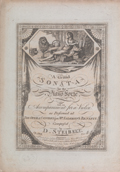 |
|||||||||||||||||||||||||||||||||||
|
THE DEDICATION COPY TOMASCHEK, Wenzel Johann (1774-1850). Sechs Gesaenge aus C.E. Eberts böhmisch-nationa- First edition, being the dedication copy with elegant binding and ownership stamp. Tomaschek is considered as one of the leading composers of Czech romanticisim; he had a very im- “Tomášek's first songs to Czech texts date from 1813 and, according to his memoirs, were composed ‘so as not to forget my mother tongue entirely’. Many were composed to verses by Václav Hanka, and were probably inspired by the success of contemporary Czech songs by Vitásek and Doležálek and by his personal friendship with Hanka” (New Grove). Order no. 0901 L066 £2500 |
  |
|||||||||||||||||||||||||||||||||||
|
VANHAL, Jan Baptist (1739-1813). Six Quartettos, for two Violins, a Tenor and Bass, Selected from the different Works of C: Vanhall. BUC p. 1055 (7 copies). RISM V 387 (10 copies). Vanhal was one of the leading composers in Order no. 0901 L067 £170 |
||||||||||||||||||||||||||||||||||||
|
VENTO, Mattia (1735-1776). Six Sonatas For the Harpsichord with an Accompanyment for a Violin or German Flute, Dedicated to Miss Blosset, Composed by Sigr. Mattia Vento. BUC, p. 1037. RISM V 1154 (3 copies). The Italian composer Mattia Vento was a student in Order no. 0901 L068 £320 |
||||||||||||||||||||||||||||||||||||
|
VENTO, Mattia (1735-1776). Six Sonatas For the Harpsichord with an Accompanyment for a Violin or German Flute, Composed by Sigr. Mathias Vento. BUC, p. 1037. RISM V 1154a (2 copies). Order no. 0901 L069 £270 |
||||||||||||||||||||||||||||||||||||
|
VERDI, Giuseppe (1813-1901). Otello. Dramma lirico in Quattro atti. Versi di Arrigo Boito. Musica di Giuseppe Verdi. Riduzioni di Michele Saladino, Canto e Pianoforte. Milano: Tito di Gio. Ricordi, [1887]. Vocal score: 4 ff., 364pp., large 8vo, plate number 51023. Publisher’s cloth with gilt lettering, faded. A very nice copy. First edition. Hopkinson 63A (p. 157). With the first performance information on title-page; first performed at La Scala on 5th February 1887. Written at the height of Verdi’s operatic compositional growth this opera is one of the highlights of the repertoire for singers. Order no. 0901 L070 £850 |
||||||||||||||||||||||||||||||||||||
|
WAGENSEIL, Christoph (1715-1777). Six Lessons for the Harpsicord or Piano Forte, Composed by ChristopR. Wagenseil of BUC, p. 1052 and RISM W 48 (both citing the same single copy). “Wagenseil was also renowned as a keyboard virtuoso, and elicited the highest praise from contem- Order no. 0901 L071 £280 |
||||||||||||||||||||||||||||||||||||
|
WEBER, Carl Maria von (1786-1826). Euryanthe. Grosse romantische Oper in 3 Aufzügen. Dich- First edition. Jähns p. 358. Hirsch IV.1290. First performed at the Kärntnertortheater in Order no. 0901 L072 £475 |
||||||||||||||||||||||||||||||||||||
|
WEBER, Carl Maria von (1786-1826). Der Freischütz, Romantische Oper in 3 Aufzügen. Dichtung von Friedrich Kind, In Musik gesetzt, von Carl Maria von Weber [Jähns 277]. Berlin: In der Schle- First edition, later issue. Jähns p. 303. Hirsch IV.1291. Fuld5 p. 236. First performed at the Konzerthaus in Order no. 0901 L073 £350 |
||||||||||||||||||||||||||||||||||||
|
WEBERN, Anton (1883-1945). Fünf Sätze für Streichquartett von Anton Webern, Op. 5. Partitur. Wien: Universal-Edition, 1922. Score, 11pp., small 8vo. Printed wrappers, edges a little worn. First edition. “If the quartet proved difficult to comprehend even for the audience of seasoned musicians assem- Order no. 0901 L074 £250 |
||||||||||||||||||||||||||||||||||||
|
WEISS, Charles N.. Trio, For Three Flutes Concertante, Composed & Respectfully Dedicated to Mr. de Mont Lambert by Charles N. Weiss, Op. 39. NB. This Trio may also be played as a Duet.
Not in the British Library. Order no. 0901 L075 £80 |
||||||||||||||||||||||||||||||||||||
|
WEISS, G. Three Trios, for Three Flutes, Composed by G. Weiss. Vester, Flute Music of the 18th Century, W92 lists the Monzani & Cimador edition of 1800. Not in the British Library. Order no. 0901 L076 £120 |
||||||||||||||||||||||||||||||||||||
